Mars 2020
[28] In September 2013, NASA launched an Announcement of Opportunity for researchers to propose and develop the instruments needed, including the Sample Caching System.It will seek signs of past life, set aside a returnable cache with the most compelling rock core and soil samples, and demonstrate the technology needed for the future human and robotic exploration of Mars.[34] Improved precision landing technology that enhances the scientific value of robotic missions also will be critical for eventual human exploration on the surface.[34] The mission will also attempt to identify subsurface water, improve landing techniques, and characterize weather, dust, and other potential environmental conditions that could affect future astronauts living and working on Mars.[40][41] Between 20 and 30 drilled samples will be collected and cached inside small tubes by the Perseverance rover,[42] and will be left on the surface of Mars for possible later retrieval by NASA in collaboration with ESA.[44] At a rock named "Wildcat Ridge" located within Jezero's well-preserved sedimentary fan deposit, Perseverance found evidence for an ancient lake environment.[45]They also found that "sediments entering Jezero's lake were deposited in a delta" and "evidence for late-stage, high-energy flooding that carried large boulders into the crater.[51] One of the upgrades is a guidance and control technique called "Terrain Relative Navigation" (TRN) to fine-tune steering in the final moments of landing.[20][59] Engineers redesigned Perseverance's wheels to be more robust than Curiosity's, which, after kilometres of driving on the Martian surface, have shown progressed deterioration.[64] A Multi-Mission Radioisotope Thermoelectric Generator (MMRTG), left over as a backup part for Curiosity during its construction, was integrated onto the rover to supply electrical power.[66] Unlike solar panels, the MMRTG does not rely on the presence of the Sun for power, providing engineers with significant flexibility in operating the rover's instruments even at night and during dust storms, and through the winter season.Space has also been found for the first time for an uncrewed helicopter, which will be controlled by NTNU (Norwegian University of Science and Technology) trained cybernetics engineer Håvard Fjær Grip and his team at NASA's Jet Propulsion Laboratory in Los Angeles.[74] Jezero today features a prominent river delta where water flowing through it deposited much sediment over the eons, which is "extremely good at preserving biosignatures".The spacecraft fired thrusters to adjust its course toward Mars, shifting the probe's initial post-launch aim point onto the Red Planet.The craft from Earth was a carbon fiber capsule that protected the rover and other equipment from heat during entry into the Mars atmosphere and initial guidance towards the planned landing site.[91] Perseverance successfully landed on the surface of Mars with help of the sky crane on February 18, 2021, at 20:55 UTC, to begin its science phase, and began sending images back to Earth.[37][111] Adjusted for inflation, Mars 2020 is the sixth-most expensive robotic planetary mission made by NASA and is cheaper than its predecessor, the Curiosity rover.[118] On February 22, 2021, NASA released uninterrupted footage of the landing process of Mars 2020 from parachute deployment to touchdown in a livestream broadcast.The parachute's pattern was based on binary code and translated to the motto of JPL (Dare Mighty Things) and the coordinates of its headquarters.
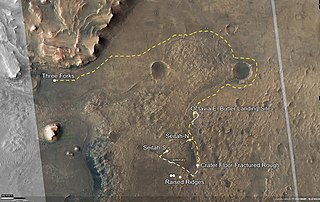


- Mars 2020
- Sun
- Earth
- Mars
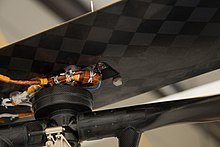
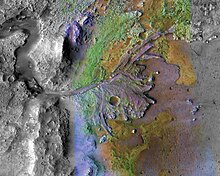

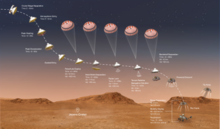
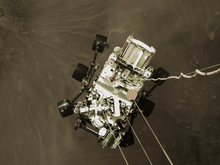

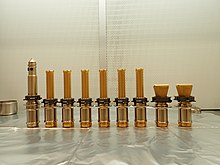
- The pointed one with two windows on the left is the regolith drill
- the two shorter ones on the right are abrasion tools
- the others in the center are rock drills
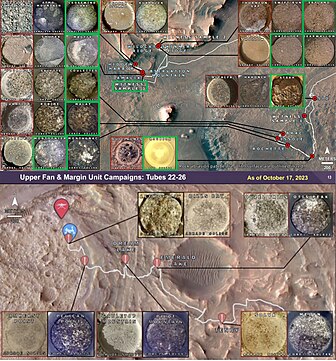
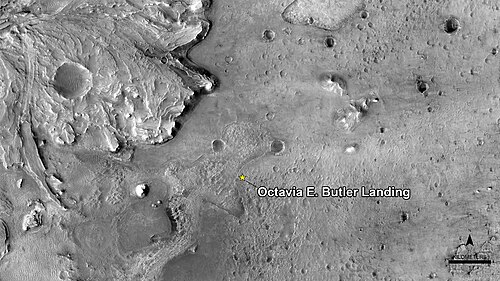
Mars
Perseverance
rover –
Octavia E. Butler Landing
Site in the
Jezero crater
(5 March 2021)

Mars
Perseverance
rover – Panoramic view of landing site (18 February 2021)

The
Ingenuity
helicopter
views the
Perseverance
rover
(left) about 85 m (279 ft) away from 5.0 m (16.4 ft) in the air (25 April 2021)

Mars
Perseverance
rover – Possible route for exploration and study
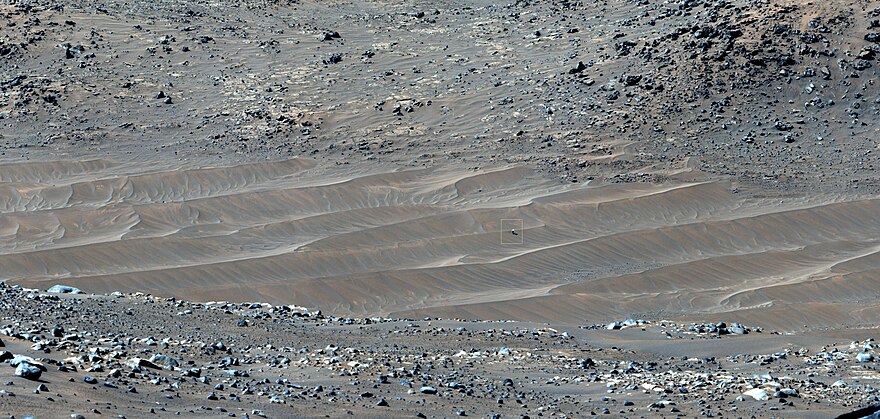
Valinor Hills
in the Airfield Chi (χ), Mars,
Ingenuity's
final airfield (see
SQUARE near off-center right of image
) as viewed by the
Perseverance
rover on February 4, 2024.


 Clickable image:
Clicking on the labels will open a new article.
Clickable image:
Clicking on the labels will open a new article.
(
Active
•
Inactive
•
Planned)
(See also:
Mars map
;
Mars Memorials list
)




Timeline of Mars 2020Self-portraitPerseveranceIngenuityWright Brothers FieldCOSPAR IDSATCAT no.Atlas V 541Cape CanaveralSLC-41United Launch AllianceOctavia E. Butler LandingJezero72 flightsLarge Strategic Science MissionsEuropa ClipperMars Exploration ProgramInSightAtlas Vtotal daysastrobiologicallysurface geological processes and historyhabitabilitylife on MarsbiosignaturesMars sample-return missionAmerican Geophysical UnionCuriositycore drillMars launch windowEmirates Mars MissionTianwen-1ZhurongAdam SchiffBill Nyehabitable conditionsAtlas V-541Jet Propulsion LaboratoryCuriosity rovercrewed missiontechnologyMartian atmosphericcarbon dioxideweathertwo-stagesolid-fueledAirbusrendezvousNext Mars OrbiterigneousEntry, Descent, and Landing SystemaeroshellMars Science LaboratoryXombie rocketPerseverance (rover)aluminiumMulti-Mission Radioisotope Thermoelectric Generatorplutonium dioxidelithium-ion rechargeable batteriesUnited States Department of EnergyRIMFAXNorwegian Defence Research EstablishmentSvein-Erik HamranNorwegian Space Centeruncrewed helicopterNorwegian University of Science and TechnologyHåvard Fjær GripWright FlyerWright brotherssolar panelIngenuity (helicopter)coaxialWater on MarsJezero craterfalse colorColumbia HillsGusev craterEberswalde craterHolden craterMawrth VallisNortheastern Syrtis Major PlanumNili FossaeMelas ChasmaPasadena, CaliforniaCape Canaveral Space Force StationUnited Arab Emirates Space AgencyChina National Space Administrationsky craneentry, descent and landingimpactbreezeMars Environmental Dynamics AnalyzerMars Oxygen ISRU ExperimentJ.R.R. TolkienCheyava FallsNASA-ESA Mars Sample ReturnregolithMartian soilSilicacementedcarbonate rockIngenuity helicopterPerseverance rovermicrochipEventbriteCOVID-19 pandemicRod of AsclepiusEaster egglivestreambinary codecoordinatesSwati MohanExoMarsExploration of MarsList of missions to MarsMars Astrobiology Explorer-Cacherpublic domainScientific AmericanBibcodeJ. (Bob) BalaramTimothy CanhamThe New York TimesYouTubeInteractive image mapglobal topography of MarsMartian rovers